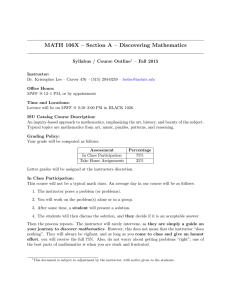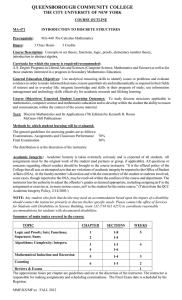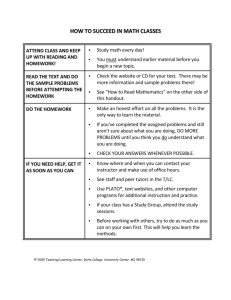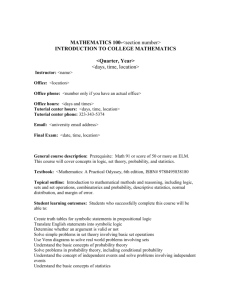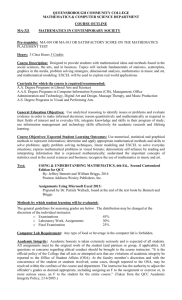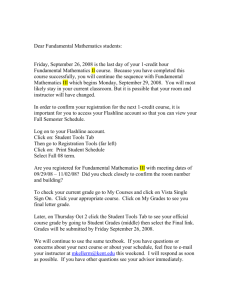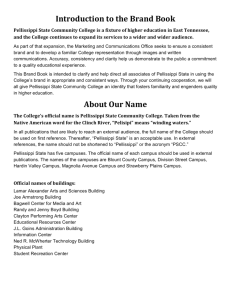MATH 1010 Survey of Mathematics - Pellissippi State Community
advertisement
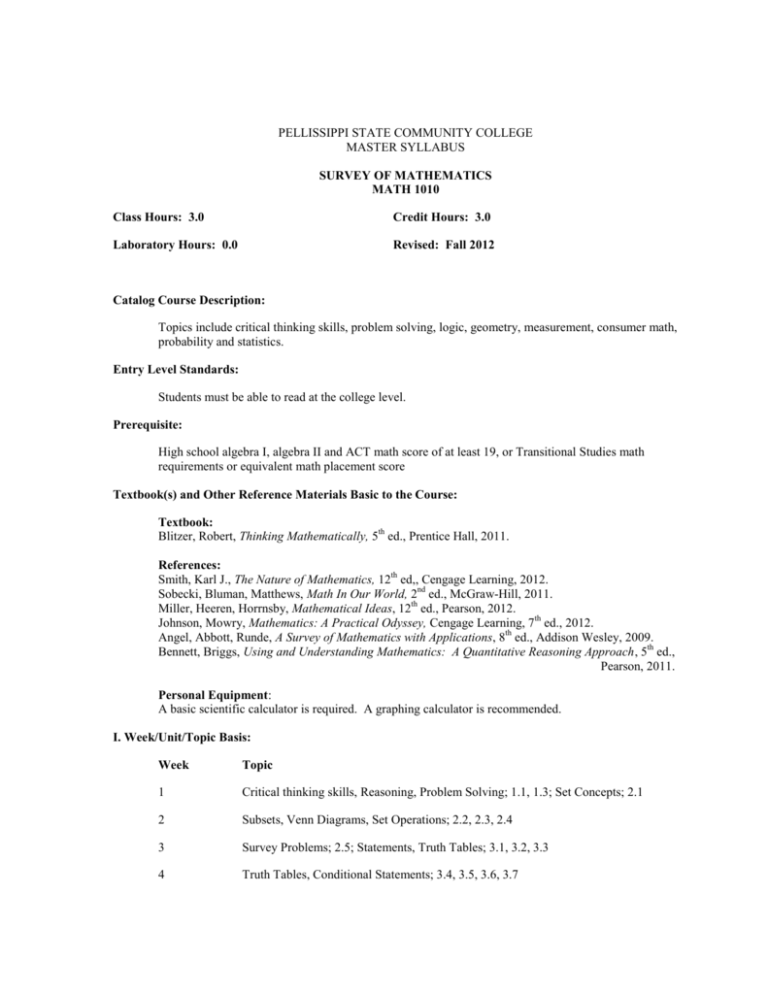
PELLISSIPPI STATE COMMUNITY COLLEGE MASTER SYLLABUS SURVEY OF MATHEMATICS MATH 1010 Class Hours: 3.0 Credit Hours: 3.0 Laboratory Hours: 0.0 Revised: Fall 2012 Catalog Course Description: Topics include critical thinking skills, problem solving, logic, geometry, measurement, consumer math, probability and statistics. Entry Level Standards: Students must be able to read at the college level. Prerequisite: High school algebra I, algebra II and ACT math score of at least 19, or Transitional Studies math requirements or equivalent math placement score Textbook(s) and Other Reference Materials Basic to the Course: Textbook: Blitzer, Robert, Thinking Mathematically, 5th ed., Prentice Hall, 2011. References: Smith, Karl J., The Nature of Mathematics, 12th ed,, Cengage Learning, 2012. Sobecki, Bluman, Matthews, Math In Our World, 2nd ed., McGraw-Hill, 2011. Miller, Heeren, Horrnsby, Mathematical Ideas, 12th ed., Pearson, 2012. Johnson, Mowry, Mathematics: A Practical Odyssey, Cengage Learning, 7th ed., 2012. Angel, Abbott, Runde, A Survey of Mathematics with Applications, 8th ed., Addison Wesley, 2009. Bennett, Briggs, Using and Understanding Mathematics: A Quantitative Reasoning Approach, 5th ed., Pearson, 2011. Personal Equipment: A basic scientific calculator is required. A graphing calculator is recommended. I. Week/Unit/Topic Basis: Week Topic 1 Critical thinking skills, Reasoning, Problem Solving; 1.1, 1.3; Set Concepts; 2.1 2 Subsets, Venn Diagrams, Set Operations; 2.2, 2.3, 2.4 3 Survey Problems; 2.5; Statements, Truth Tables; 3.1, 3.2, 3.3 4 Truth Tables, Conditional Statements; 3.4, 3.5, 3.6, 3.7 5 Review, Test 1; Percent, Taxes, Simple Interest; 8.1, 8.2 6 Compound Interest, Annuities, Loans, Credit Card Interest; 8.3, 8.4, 8.5 7 Review, Test 2; Measurement, The Metric System; 9.1 8 Measuring Area, Volume, Weight, and Temperature; 9.2, 9.3; Basic Geometry and Triangles; 10.1, 10.2 9 Perimeter, Area, Circumference, Volume; 10.3, 10.4, 10.5; Review 10 Test 3; Counting, Permutation, Combinations; 11.1, 11.2, 11.3 11 Probability; 11.4, 11.5, 11.6 12 Probability, Expected Value; 11.7, 11.8; Frequency Distributions and Graphs; 12.1 13 Statistical Measures; 12.2, 12.3; Review; Test 4 14 The Normal Distribution; 12.4, 12.5; Review for Final 15 Comprehensive Final Exam At the discretion of the individual instructor, some changes in the above schedule are possible for this course. Some textbook sections may be added and some sections may be omitted, especially Sections 3.7 and 9.2. II. Course Goals*: The course will : A. Guide students to translate verbal and written situations into a problem-solving format. VI.3, 4 B. Guide students to master the logic necessary to interpret logic with items such as set notation, Venn diagrams, and truth tables. VI.1, 3, 4 C. Guide each student to master the critical thinking skills necessary for success in the student’s discipline and life. VI.2, 4 D. Guide students to master geometric principles necessary for success in the students’ disciplines. VI.2, 3 E. Enhance the effective use of mathematics to solve personal everyday financial problems. VI.1, 2, 3, 4, 5 F. Enhance the students’ knowledge of the basic principles of probability and guide students to solve basic problems in probability and statistics. VI.2, 4, 6 G. Enhance the students’ ability to collect and assemble quantitative data, making wide use of tables and graphs. VI.3, 4, 5, 6 H. Guide students to apply principles in statistics to solve real-world problems. VI.2, 4, 6 *Roman numerals after course objectives reference goals of the mathematics program. III. Expected Student Learning Outcomes*:*: The student should be able to: 1. Use set notation and Venn diagrams in application problems. B 2. Utilize inductive and deductive reasoning. A, C 3. Draw conclusions as a result of using truth tables and the laws of logic. A, B 4. Translate verbal and written situations into problem-solving models. A, C, H 5. Solve problems using geometry. A, D 6. Solve measurement problems involving metric system units. A, G 7. Calculate simple and compound interest, annuities, and loans. E 8. Solve basic probability problems. F 9. Graph a frequency distribution as a bar graph and a line graph. F, G 10. Use normal curves and z-score tables to solve applied problems. A, C, G, H *Letters after performance expectations reference the course objectives listed above. IV. Evaluation: A. Testing Procedures: Testing Procedures: 90% to 100% of grade. Students are evaluated primarily on the basis of tests, quizzes and assignments, and a comprehensive final exam. A minimum of 4 chapter tests is recommended. B. Laboratory Expectations: None. C. Field Work: None. D. Other Evaluation Methods: 0%-10% of grade. An assigned project can count no more than half of an individual test grade; where appropriate, grammar and syntax will be evaluated in addition to the content. Other as assigned by instructor. E. Grading Scale: 93 - 100 A 88 - 92 B+ 83 - 87 B 78 - 82 C+ 70 - 77 C 60 - 69 D Below 60 F V. Policies: A. Attendance Policy: Pellissippi State expects students to attend all scheduled instructional activities. As a minimum, students in all courses (excluding distance learning courses) must be present for at least 75 percent of their scheduled class and laboratory meetings in order to receive credit for the course. Individual departments/programs/disciplines, with the approval of the vice president of Academic Affairs, may have requirements that are more stringent. In very specific circumstances, an appeal of the policy may be addressed to the head of the department in which the course was taken. If further action is warranted, the appeal may be addressed to the vice president of Academic Affairs. B. Academic Dishonesty: Academic misconduct committed either directly or indirectly by an individual or group is subject to disciplinary action. Prohibited activities include but are not limited to the following practices: • Cheating, including but not limited to unauthorized assistance from material, people, or devices when taking a test, quiz, or examination; writing papers or reports; solving problems; or completing academic assignments. • Plagiarism, including but not limited to paraphrasing, summarizing, or directly quoting published or unpublished work of another person, including online or computerized services, without proper documentation of the original source. • Purchasing or otherwise obtaining prewritten essays, research papers, or materials prepared by another person or agency that sells term papers or other academic materials to be presented as one’s own work. • Taking an exam for another student. • Providing others with information and/or answers regarding exams, quizzes, homework or other classroom assignments unless explicitly authorized by the instructor. • Any of the above occurring within the Web or distance learning environment. Please see the Pellissippi State Policies and Procedures Manual, Policy 04:02:00 Academic/Classroom Conduct and Disciplinary Sanctions for the complete policy. C. Accommodations for Disabilities: Students who need accommodations because of a disability, have emergency medical information to share, or need special arrangements in case the building must be evacuated should inform the instructor immediately, privately after class or in her or his office. Students must present a current accommodation plan from a staff member in Services for Students with Disabilities (SSWD) in order to receive accommodations in this course. Services for Students with Disabilities may be contacted by going to Goins 127, 132, 134, 135, 131 or by phone: 539-7153 or TTY 694-6429. More information is available at http://www.pstcc.edu/sswd/. D. Other Policies: Make-up work: Instructor discretion about make-up tests and/or assignments. Cell phones: Cell phones are to be either turned off or put on vibration mode while in class. Instructor discretion as to penalty.
